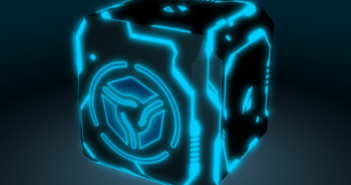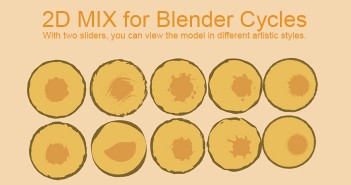Here's a fascinating research video that shows structures that grown very much like natural organisms.
The video shows 15 different variations of one computational growth process. Based on this process we created a series of 3D printed wearables in cooperation with Prof. Neri Oxman from the MIT Media Lab. More about the project can be found on our Behance page.
The audiotrack "There's Probably No Time" from Chris Zabriskie, which is used in this video can be found on the freemusicarchive.





31 Comments
whoa this is weird. this video makes me feel nervous.
Why is that? :) To me it feels like a time lapse of plants growing.
very intersting, I also experienced uneasy feelings. I wonder if it's genetic that some people would feel that way and others wouldn't. Overall, a very interesting video.
Some look like cancer :) Or maybe like i would imagine cancer.
But really cool structures though.
This is wonderful!
It's not only an analogy to plants, but many animal forms can be described by these transformations.
It is just impressive how many shapes in nature can be approached by a computational iteration.
The analogies I could see:
Variant 1 = dermal structures in reptiles,
Variant 2 = brain corals or stomach skin
Variant 3 = Nudibranchs (sea slugs) and Polyclads (Flatworms)
Variant 7 = skin projections in the Leafy Seadragon
Variant 9 = inside of an ant or termite nest
Variant 10 = the mineral skeleton of Radiolarians or the nanostructure of butterfly wing scales
Variant 11 = more corals
wonderful,
I'm curious what software was used for simulation?
according to the website, the computational growth process was developed by MIT media lab, probably under the supervision of Prof. Neri Oxman. So, at least the code and the mathematics behind of it seems to be some MIT in-house production.
Taking a quick look at her publications, it looks like it was fully in-house development.
This is Neri's website if you want to find more info about her, her research, exhibitions, publications and courses: http://neri.media.mit.edu/
It doesn't seem that it was a simulation in the sense of a Physics-based simulation, but more of a morphing deformation ("shape-keys" in Blender). Maybe something like a Procedural Morphing.
seriously, for me this looks more like Houdini stuff :))
nice idea, I never thought about mixing shape keys with procedural displacement
Not really, these results seems to follow from previous work from the German duo in a Quaddel algorithm.
It seems Oxman approached them and contracted further improvements. The publications from Oxman are more focused on manufacture processes and 3D printing.
Those guys are quite smart, and it seems they are keeping the details for themselves by now. Probably they are far more interested in the unique forms generated than publishing scientific papers.
That said, this videos really shows groundbreaking results. Not only for computer graphics, but for biology researchers interested in mophogenesis.
Deskriptiv ( http://www.deskriptiv.de ) use houdini ( http://www.sidefx.com ) in some projects and develop software on their own, as well. so i don't think the video has been created at MIT.
I found that the method is called Quaddel:
https://www.behance.net/gallery/13734827/Quaddel
It seems as if there are no more information available about the algorithm behind that. Does anybody have an idea of how this might work?
I guess that is some constrained quad-tree-based surface. That is, not as general subdivision surfaces, but more akin to voxel subdivision, like marching cubes or tetrahedrons.
Such techniques are well known for decades, but the devil is in the details. Amazing results, indeed!
I took more than one hour searching, but I could not find any more technical details beyond the terse descriptions and the videos.
But those guys just ENTERED university, so we may expect some scientific papers in a while...
Neri worked with "Deskriptiv", which seems to be a group of two students development these generative procedural methods. http://www.deskriptiv.de/
I didn't see any of her publications with the Deskriptiv students as co-authors, so maybe the method wasn't published yet. Maybe they just presented it in some conference or are just showcasing the videos online...
Yeah, probably the duo is more interested in the artsy generative visuals than in publishing their proprietary algorithms.
That's a pity, however this may be the smartest move for the Design World, so they keep their "secret sauce" and therefore their distinctive style.
I'll be following their Facebook page, as their portfolio is truly awesome:
https://newevolutiondesigns.com/the-generative-designs-of-deskriptiv
That's looks like Mushrooms!!
I don't know what it is but I think it has simularity to QML explorer in Gimp.
How they do this :o ? It is so amazing
This could be useful for creating bones protheses or a lightweight structure for the tucan beak in an article read before....both are hollow and have a very strong microstructure as seen with the variant starting from the cube or sphere.
Depending on how this method works, I also see potential use-cases for computational and comparative neuroscience. I was wondering whether this approach is more about expanding the surface area at certain points or whether a dynamic system (some sort of fluid system) generates the shape which is then covered by a mesh.
Hi Martin,
I don't think its a simulation based system, but a procedural generative algorithm.
Probably similar to the technique that Deskriptiv created previously, here: https://www.youtube.com/watch?v=NcftEcsgUeE
It feels a bit like the idea of Morphing, but without a final target shape. The fate of the deformations is defined by a series of parameters.
That would be a great way to "simulate" morphological evolution!
It is also very similar to mandelbulbs (3D mandelbrot fractals). You can experiment with 3D fractals using free softwares such as "Mandelbulber" (http://www.mandelbulber.com/), or Mandelbulb3D (http://mandelbulb.com/2014/mandelbulb-3d-mb3d-fractal-rendering-software/)
I think the process is more similar to local surface expansion, given some set of rules, like maximizing surface area.
Because they detect collisions and somewhere also says that perform union, I suspect they are using an adaptive octree. This is also hinted by the consistent level-of-detail as the growth evolves.
I'm doing my PhD in a related area, and this is really groundbreaking. Never seen such diversity of REAL organic shapes generated by computer algorithms. Even more impressive, although not unexpected, that they are all results from the SAME ALGORITHM.
People from biology will go nuts over these images...
Hi Marcelo!
Yup, I am going nuts over these images. Could identify so many different organisms.
Anyway, what is your PhD about? I'm quite interested in the application of such stuff in studies of organismal evolution and development.
Regards,
Diego
Hello, Diego.
I'm currently researching on animal pigmentation patterns, from the Computer Graphics point-of-view. However, a read a lot from biological papers to follow recent studies in the area of morphogenesis.
It seems this is still a scarcely researched topic, and the most active groups are from developmental biologists. In Computer Graphics the most interesting results were attained by people dealing with Reaction-Diffusion, but its been quite a while since a significant discovery has been made. I can cite the seminal work by Greg Turk and "Advanced reaction-diffusion models for texture synthesis" from Sanderson. Another quite interesting work is Xmorphia:
http://mrob.com/pub/comp/xmorphia/
On the biological front, there is very interesting work by the team led by Kondo. I recommend reading the gentle introduction "Reaction-diffusion model as a framework for understanding biological pattern formation" that appeared on Science.
Regarding growing surfaces and 3D models, there has been very little on the last years, so I was amazed by the results from Deskriptiv. Mostly what exists by now are much simpler growth models, like the one by George Hart:
http://www.georgehart.com/Growth/growth.html
On the theoretical side, people from biology are still debating among several approaches that try to explain morphogenesis. A recent paper that sum things up is "Studies of morphogens: keep calm and carry on", by Stathopoulos.
I really hope Bader and Kolb open up their algorithms, as it seems they have unlocked a major discovery for the modelling of growing forms!
Regards,
Marcelo
I am interested in the application of such stuff in the evolution of neural networks.
In Artificial Evolution there is an algorithm called "Compositional Pattern Producing Networks" which can produce some nice organic and evolvable forms
http://eplex.cs.ucf.edu/papers/stanley_gpem07.pdf
But CPPNS skip the developmental part. This approach here seems to be much more biological plausible.
Best,
Martin
Hello, Martin.
Thanks for the paper, it seems an interesting approach. However I disagree with the conclusion that local interaction is not important.
I think the key approach to growth models have two equally important parts: you need to have overall consistent and global rules concerning the growth, so the resulting parts are similar, but you also need to have local interaction to be adaptable.
Therefore the analogy to biology is obvious: you have DNA-encoded rules shared by all organism cells, however each one functions independently and only interact to nearby cells. Given enough cells and enough time, simple interactions following simple rules should ensue complex results.
I think the main question is: which interactions and which rules are relevant do biological organisms regarding the generation of form?
I think this is still an under-researched are, unfortunately.
Regards,
Marcelo
Sorry, it should read:
"I think the main question is: which interactions and which rules are relevant TO biological organisms regarding the generation of form?
I think this is still an under-researched AREA, unfortunately."
I completely agree with your opinion on the key approach to growth models and the fact that this area is under-researched. However, I think, that CPPNs (and the underlying NEAT and HyperNEAT-scheme) are the state-of-the-art in public sience. But given the animations by Deskriptiv this looks like nothing.
On the other hand, I am afraid that the algorithm behind this animations does not have a strong analogy to natural growth processes in the sense that you could make some valuable predictions of natural growth processes or representing real gene-regulatory networks with it. But it makes me think of how such a model could look like.
btw: where do you work. do you have any public profile. Would be nice to keep you in my network.
Hey guys, if you want to exchange email addresses you can both email me and I'll handle it. That's probably a more private approach that posting it here on the site.
Thank you, Bart. Done that!
Thanks Bart, for your offer. I got already his email-address.